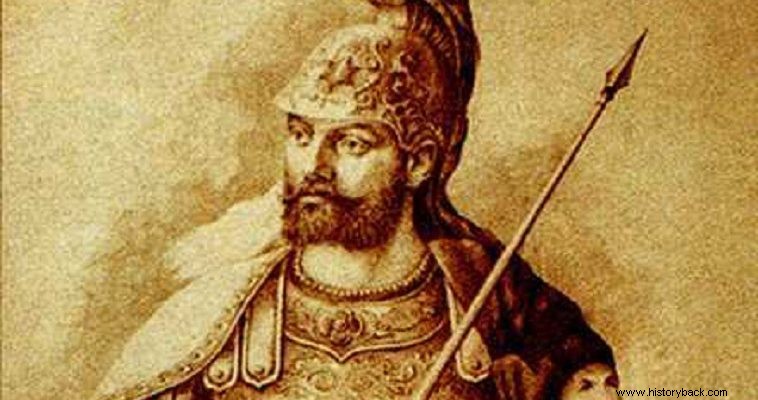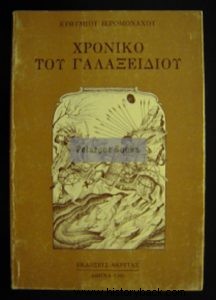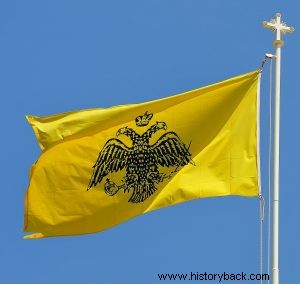
Constantinos Palaiologos, the last emperor of Constantinople, the "Marbled King", apart from his heroic sacrifice in 1453, was not a common personality of his times.
He was born on February 9, 1404, or according to others on February 7, 1405. He was the eighth child of Emperor Manuel Palaiologos and Irene Dragasis-Paleiologos. He took action early on, alongside the brothers of Ioannis, the later emperor, and Theodoros, despot of Mystras. In 1417, the Paleologians campaigned against the Frankish ruler of the western Peloponnese, Centuriona Zakarias, whom they defeated and forced to hand over part of their possessions to them. of.
During this time, the young Konstantinos was trained in warfare and in the governance of the state. In 1423, at the age of just 19, he took on the role of liaison to his brother Theodoros. He remained despot until the end of 1448, when he was anointed the successor of the deceased emperor John, with a short break, when he was appointed lord of the cities of Anchialos and Mesimvria on the Thracian coast of the Black Sea.
In this period of 25 years, Constantine emerged as the greatest military figure that the Empire displayed in those harsh years. For this reason he earned the nickname "dragon" from his subjects. In 1424, John Palaiologos was forced to make the Empire a tax vassal to Sultan Murat, handing over the neighboring cities to him as well.

Then Constantine went to Mystras, where with the consent of the emperor John and the local rulers, he assumed the governance of the Peloponnese, while his brothers Theodoros and Thomas assumed the governance of the southern and eastern Peloponnese, respectively. As soon as he assumed the reins of government, Constantine decided to clear the Peloponnese once and for all from the Franks.
On May 1, 1428, his troops captured Glarenza, seat of the Zakaria hegemony. Only Patras remained in Frankish hands, but it too was liberated in 1429.
These successes of Constantine, at the military and diplomatic level, resulted in the unification of the entire Peloponnese, except for the Venetian possessions, under Greek administration, after 220 years of Frankish occupation. This fact was particularly important, if one takes into account the plight of the royal city, which stood alone, surrounded by Turkish possessions.
The now free Peloponnese could become the center of the renaissance of Hellenism, from which the flame of the liberation of the other enslaved regions would spring up.
These successes made Constantine bolder. Then he conceived the plan to liberate Greece. The first attempt was made in 1434. In this year, the Florentine Duke of Athens, Antonios Atzaioli, died. Constantine seized the opportunity and tried to come to an agreement with his Greek widow Maria Melissini and her chief adviser Chalkokondilis.
At the same time Frantzis at the head of the army marched towards Athens. But then the deceased's nephew, Nerio Ajagioli, intervened and took over the authority, with the support of the Turks. The following year the emperor John invited Constantine to the city and assigned him the duties of regent.
The emperor himself moved to Europe hoping for the support of the West. The consequence of his journey was the Synod of Ferrara-Florence (1439), for the union of the churches in exchange for the support of the West in the life struggle given by the empire.
Constantine ruled the state for six years, until his brother returned from Europe. Apart from the reaction of the Byzantines to the union of the churches, the time had now passed when, at the behest of the pope, thousands of Western Europeans rushed to fight for the "faith".

As Stalin said centuries later, "the pope is good, but how many divisions does he have"! And at the given time the pope had neither divisions nor serious influence in the political affairs of the West.
As for the Greek forces, we could say that they were too limited. With little income, cut off from the rest of the world, a lonely island, lost in the unfaithful sea, the City no longer possessed either the old glamor and brilliance, nor the military power necessary for its survival, under the prevailing conditions.
The total regular forces available to the last Paleologian emperors did not exceed 3,000 men, under Andronikos III. Gradually this number decreased even more. A typical example is the campaign of Vousikos in the East.
The French Vousiko was hired together with 100 horsemen and 1,000 footmen by the emperor Manuel Palaiologos in 1398. With these few, but well-equipped and experienced men, Vousiko almost cleared Thrace of the Turks. Lacking financial resources, however, he left the following year for France.
Byzantium had reached such a loss that it could not maintain 1,100 men. In addition to the regular forces, there were also the "militias", so to speak, those able to bear arms, i.e. citizens, who were recruited in cases of need.
But they neither had serious equipment, nor, most importantly, military training and experience. And neither could they be trained as soldiers, since all of them had survival as their primary concern. The estates ravaged by wars and Turkish raids were left uncultivated.
Then the spread of the Turks limited the Byzantine territory around Constantinople, Epivates and Silivria. The economic collapse had as a natural consequence the decline in the standard of living, to the point of impoverishment.
To avoid starvation, thousands fled to the various monasteries and took the form. Constantinople itself was not inhabited by more than 60-80,000 people, including foreigners. The only ray of light came from the Peloponnese.
And there, however, things were not as rosy as they seemed. In addition to the discord between the various lords and the despots Palaeologos, there was also discord between the members of the imperial family themselves, a discord that proved destructive to the national cause. On the other hand, even the Peloponnese did not have the necessary human resources and the necessary financial resources to strengthen the encircled Vasilevousa, both during the final siege and earlier.
The regular army of the despots was small, numbering a few hundred "cavalry" horsemen and "kontarat" (satellites) footmen. In these forces the respective despot added a small number of Frankish mercenaries, who constituted the best part of the army. the despots also had a relatively large number of light cavalry, the famous "Soldiers".
But the bulk of the military forces of the despotate were simple peasants, free cultivators, or serfs of the "Powerful". Equipped primarily with bows, lacking breastplates and having a strong aversion to enemy cavalry charges, they were useful for 'stealth warfare' missions or sieges, but not for line combat. They also usually refused to campaign across the Isthmus.
Constantine remained in the city until 1444. Then he returned to Mystras and took over the governance of the despotate with his brother Thomas. In the meantime new political facts appeared in the peninsula of Aimos. In Epirus, Ioannis Kastriotis had risen up against the Turks.
Further north, the Hungarian John Unniadis was also successfully fighting the Ottomans. All indications were that the Asian plague could be fought. Constantine carefully studied the new developments and decided to act.
Then he conceived the bold plan to advance to the north and, after uniting with Kastriotis and Unniades, all together strike the Turks. So he acquired diplomatic contacts with the other warrior rulers, but also with the pope. From the latter he asked for military and financial help. It seems that he finally got something, since in 1444-45 he managed to reinforce his army with 300 Burgundian knights.
Constantinos, as a first measure, rebuilt the wall of Hexamilion, on the isthmus, in order to secure the despotate. Having made the "shield" he decided to take the spear in hand. The time had come to attack.
The moment was indeed opportune because the Turks and the dreaded Sultan of Murat were preparing to face the Christian army that had reached Bulgaria. Constantine knew that the campaign was imminent, since he was in contact with Unniades.
Papal representatives even arrived in Mystras, through which a kind of conflict between Greeks and Hungarians was concluded. After this, Constantine and Thomas set off for Athens.
The Greek despots obliged the Frankish dynast to submit and pay an annual tribute of 30,000 ducats. They preferred not to dethrone him in order not to provoke the enmity of the West.
However, they annexed Boeotia to the state of Mystras, which they made the base of their operations. Then they returned to the Peloponnese. There they also received the unpleasant news of the defeat of the Christian forces in the battle of Varna.
At Mystras Constantine reassessed the situation, which was clearly now looking more unfavorable. Nevertheless, Constantine did not lose his courage. Trusting in the same powers and abilities he decided to challenge the beast himself. Thus, in February 1445, an expedition to the North was undertaken.
From Boeotia the forces of the Paleologues marched towards Phocis and central Sterea. As the Chronicle of Galaxidi informs us, a great and victorious battle was fought with the Turks outside Salona.
Then the army of the Paleologues occupied Lidoriki and all of Phocis and reached Thessaly. The Greeks of Thessaly immediately rose up against the Turks. In a very short time, almost the entire mainland of Greece had been liberated, from Athens to the outskirts of Pindos.
However, Murat, with his back secured after his triumphant victory in Varna, immediately sent reinforcements to Greece. Heavily reinforced, "with incalculable askeri", as the Chronicle of Galaxides says, the Turks turned against the forces of the Paleologues. Unable to resist the overwhelming superiority of the Turks, they were forced to retreat to the Isthmus, behind the wall of Hexamile.
In the meantime, Murat himself had rushed to the area. The sultan recaptured Phocis and Thebes. In fact, he handed the latter over to his favorite Adjaioli. Then together with the famous general of Turakhan they turned against Hexamilius.
Constantinos tried to come to an agreement with the Serbian ruler George Vrankovic, whom he asked to take a counter-distraction action, which would relax the Turkish pressure on him.
At the same time, he turned to the Venetians, asking them for immediate help, which they could provide him from the garrisons they maintained in the Peloponnese. They all promised to help. But in reality they did nothing. Thus, Constantine finally found himself alone against the totality of the Turkish forces, which are estimated at 80-100,000 experienced men.
On November 27, 1446, the numerous Turkish army appeared in front of Hexamilio, possessing a number of siege engines, even cannons. On December 7, 1446, the Turks attacked and took control of the fortress and proceeded slaughtering and plundering.
First Corinth was conquered and plundered and then Sicyon. Aegio and Patras had the same fate, except for its citadel, whose defenders withstood all the enemy attacks.
In order to save the rest of the Peloponnese as well, Constantine then agreed to pay a tax to the Turks, in order for them to leave the Peloponnese. Only then did the ferocious sultan leave.
